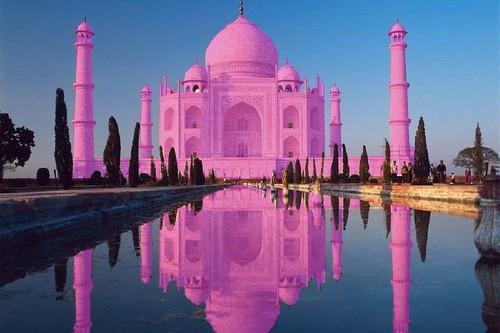Everyone recognizes the Taj Mahal as one of the Seven Wonders of the World. The mausoleum is a glorious structure, built of white marble, and symbolizes purity, love and pain, like no other architecture does. Nobel Laureate Rabindranath Tagore called the Taj Mahal “a tear drop on the cheek of time.” The Taj Mahal, built in Agra, India, has many stories revolving around it. Let us look at some of the interesting facts about Taj Mahal.
1. Shah Jahan and Mumtaz Mahal
Mughal Emperor Shah Jahan had the Taj Mahal built in memory of his third wife, Mumtaz Mahal, whom he held precious. Mumtaz Mahal was giving birth to the fourteenth child of the emperor, and she died in the process. This was in 1631. Legend has it that Shah Jahan, who considered his empress an integral part of his life, was broken after her death, and within just a few months, his hair and beard grew snow white, such was the terrible impact of the demise upon him.
2. Time and amount
The construction of the Taj Mahal was begun in 1632, a year after the death of Empress Mumtaz. The construction was completed in the year 1653, which means that it took approximately 22 years to complete this astounding piece of architecture. At that time, the estimated construction cost was a whopping sum of Rs. 32 million, which, when considered in terms of today’s value of money, would be something way above $1 billion.
3. Construction and employees
The architect behind all the magic was Ahmed Lahauri. He put more than 20,000 people into building the Taj, including labourers, stonecutters, painters, embroidery artists, calligraphers, and many others. But, how were the stones and materials required for the construction of the mausoleum transported? Well, elephants were employed to do the task, and amazingly, there were more than 1,000 of the majestic creatures employed.
4. Materials Used
The magnificent edifice is bounded on three sides by red stone walls. It is constructed completely of white marble. The emperor had marbles of the best quality brought from Rajasthan, Afghanistan, Tibet and China. But this was probably not enough for the emperor. It is believed that more than 28 different types of precious and semi-precious stones, including the striking lapis lazuli, were inlaid into the marble. Now we know where all the money went.
5. Inscriptions
The Taj Mahal being the dedication and homage of Mumtaz Mahal, it has calligraphy all over the interior and exterior, which, among other patterns and holy inscriptions, also has calligraphy on the tomb that identifies and praises Mumtaz Mahal. Another interesting fact is that there are 99 names of Allah found on the sides of the actual tomb as calligraphic inscriptions. After all, Shah Jahan did envision Mumtaz’s home in the paradise, and Taj Mahal was that imagination coming to life.
6. The Perfection that Taj Mahal Is
The Taj Mahal is one of the world’s most symmetrical structures. Its four sides are perfectly identical, built using the principles of self-replication and symmetry in geometry and architecture, thus creating a mirrored image on either side. But, to keep the male tomb larger than the female, the two tombs inside are unequal in size. The four minarets were prudently built slightly outside of the plinth, so that if they fell, they would fall outside, and not upon the main structure.
7. Changing Moods of the Taj Mahal

Did you know that the Taj Mahal dose different colours at different times of the day? The white marble and the reflective tiles help the Taj change colours. In the early morning, it assumes a shy pinkish hue, which turns to a glowing white as the day rolls on, and turns a burnished golden at night in the moonlight. The Taj Mahal is a particular attraction when on full moon nights. The changing colours are said to be analogous to the moods of a woman – Mumtaz Mahal, to be specific.
8. Attack on the Taj Mahal
The rebellion of 1857 took a toll on the Taj which was partially damaged. The soldiers had also chiselled out some of the stones and lapis lazuli, and the garden was harmed. At the end of the 19th century, Lord Curzon, the erstwhile Viceroy of British India, ordered its renovation through an extensive project which was completed in 1908. The garden that we see today was incorporated to restore the lost elements of the Charbagh. He also gifted a chandelier, which hangs in the Taj Mahal.
9. Myths
One of the common myths about the Taj Mahal is that Emperor Shah Jahan had the thumbs of the workers chopped off, to prevent them from constructing a replica of his masterpiece. However, this is not true. Another popular myth suggests he wanted to build a black Taj Mahal, but was unable to execute his plan after being deposed. The idea probably generates from European traveller Jean-Baptiste Tavernier’s fanciful writings, but has no evidence to support its validity.

nice post,I enjoyed reading this post.
ReplyDeleteLearn Digital Academy